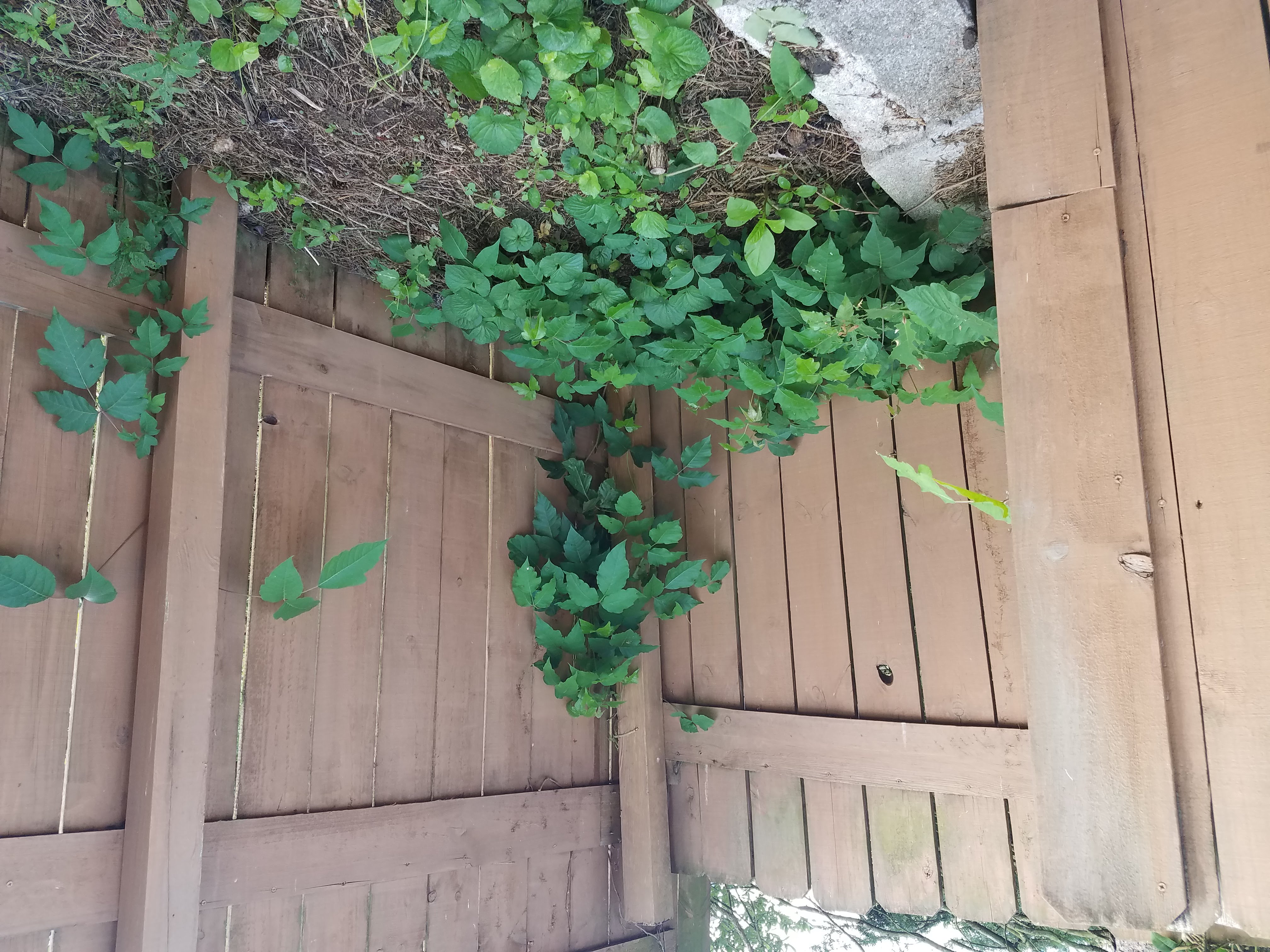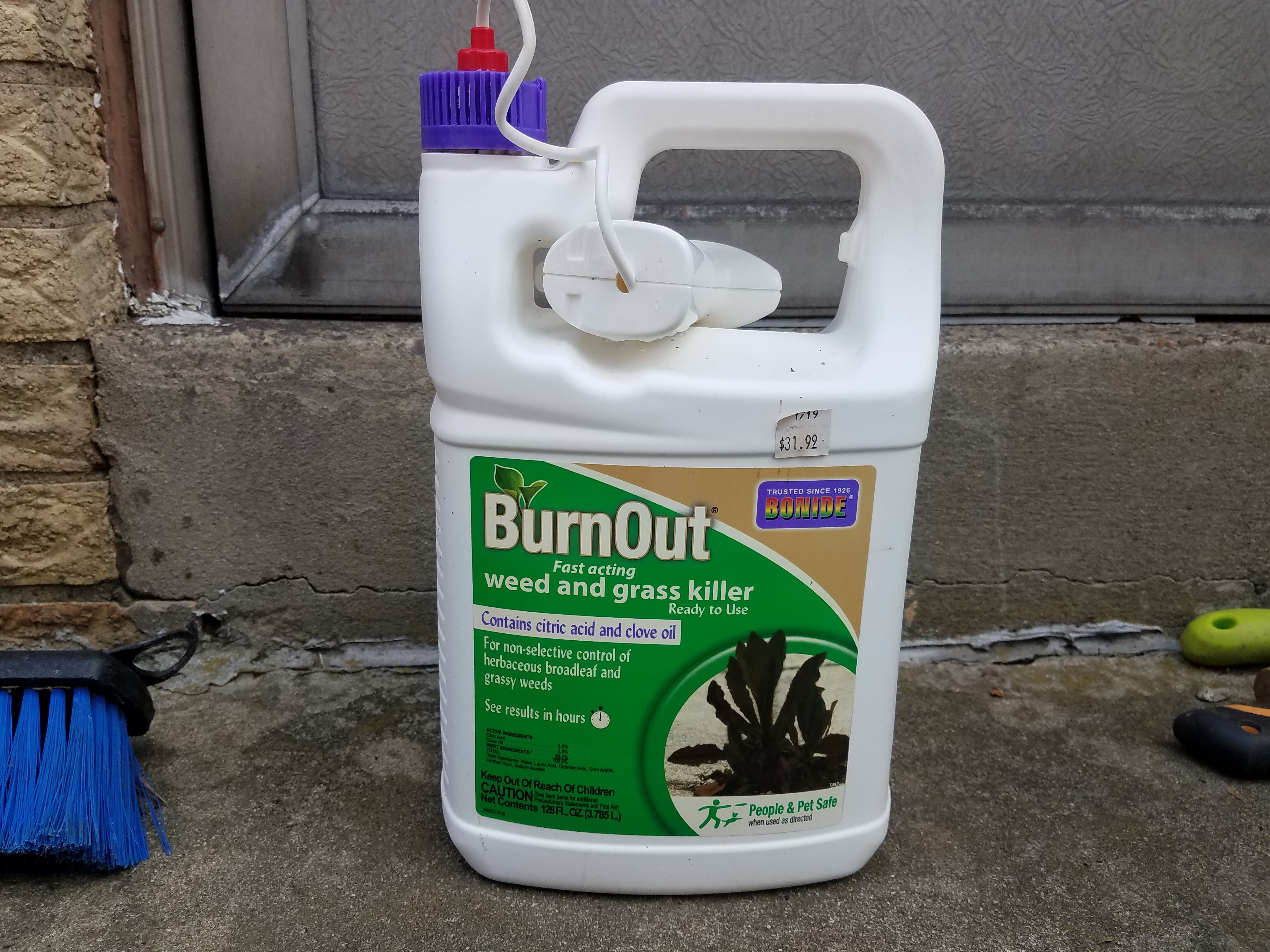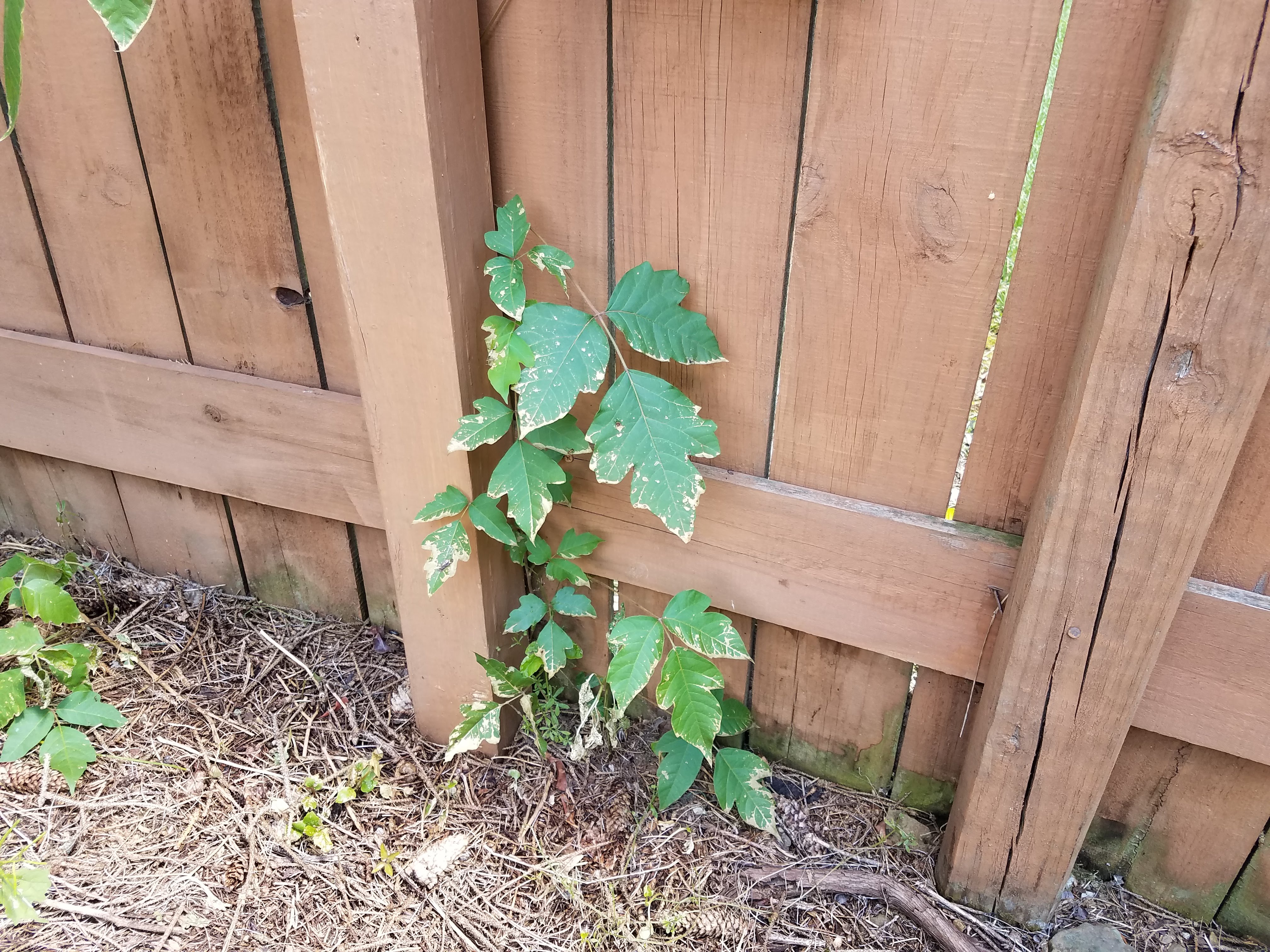While clearing out my back yard this spring, I saw what appeared to be poison ivy growing on our fence. This is the first year I had cleared enough weeds and brush to get a good look at the rickety fence that is well past its useful life, so I’m not surprised I hadn’t noticed it before.
“Leaves of Three, Leave Them Be”
Poison ivy (and similar plants like poison oak and sumac) contains a toxin in the sap called urushiol oil. It is a skin irritant and can cause itchy blisters after contact if you are allergic. The first step to avoiding them is knowing what they look like. The FDA shares this information on identification… [1]
- Poison Ivy: Found throughout the United States except Alaska, Hawaii, and parts of the West Coast. Can grow as a vine or small shrub trailing along the ground or climbing on low plants, trees and poles. Each leaf has three glossy leaflets, with smooth or toothed edges. Leaves are reddish in spring, green in summer, and yellow, orange, or red in fall. May have greenish-white flowers and whitish-yellow berries.
- Poison Oak: Grows as a low shrub in the Eastern and Southern United States, and in tall clumps or long vines on the Pacific Coast. Fuzzy green leaves in clusters of three are lobed or deeply toothed with rounded tips. May have yellow-white berries.
- Poison Sumac: Grows as a tall shrub or small tree in bogs or swamps in the Northeast, Midwest, and parts of the Southeast. Each leaf has clusters of seven to 13 smooth-edged leaflets. Leaves are orange in spring, green in summer, and yellow, orange, or red in fall. May have yellow-greenish flowers and whitish-green fruits hang in loose clusters.

Approximately 85% of the general population is allergic to urushiol oil. While I am not about to rub up against our vine to confirm that I am in the remaining 15%, I can say that I have never had a reaction that would indicate contact, despite all the time I have spent outside during my life. Despite my time in Girl Scouts, I have never been good at identifying it, so it’s very likely I have come into contact with it. As a matter of fact, I know I have: this past spring, when I cleared our old vines from the fence without realizing what it was or taking any precautions.
Meet the Neighbors
I referred to it as “our” vine, but from what I could tell, it was encroaching through our fence from the other side, meaning it belonged to our neighbors, not to the side, but behind us. Thanks to all of my yardwork activities over the past year, I have met more of my neighbors during quarantine than I knew before quarantine. I had previously spoken about weeds with our next door neighbor “M,” but I had never met or seen the neighbors behind us. With our houses facing away from each other, we’ve never had reason to interact. Pretty much all I knew about them was that they (like most of our closest neighbors) use a chemical lawn service.
I often despair over the fact that my best attempts to keep an organic garden are thwarted by something as uncontrollable as the wind, since I have seen neighbors on at least three sides of us using harmful chemicals on their manicured lawns. Since I felt pretty confident that these neighbors would throw some high-powered glyphosate product at the poison ivy once they found it, I decided that the best defense is a good offense, and that I was going to take care of it myself – but I didn’t want our first encounter to involve me digging around in their yard.

Christian and I walked over to introduce ourselves so I could let them know about the poison ivy and what I had planned. It turns out the husband, “J,” is very allergic, so he was more than happy to let me get rid of it, however I planned to do it. He’s also allergic to bees, so I promised to let him know if I ever got the hive(s) I’ve been wanting for several years.
Clearing Toxic Weeds
When it comes to clearing poison ivy (or any of the others), there are a couple options if you don’t want to take the Roundup route. I know people who are “emergency room allergic,” and for that reason, they will only ever take the nuclear option. However, glyphosate and other high-powered herbicides come with their own risks to humans and pollinators alike.[2] With a little caution, you too can clear the threat without causing additional harm to those enjoying your yard.
The following recommendations from Organic.org [3] list some options in order from the least amount of contact to the most:
- Graze a goat there. Spanish and Angora goats are especially fond of poison ivy.
- Vinegar spray. White vinegar will kill poison ivy, though it might take a few days to notice. Fill your garden sprayer with straight, undiluted white vinegar and take aim at the poison ivy leaves and crowns. Try not to soak the ground, since it will result in inhospitable acidity in the soil. If you want, you can use calcitic lime to neutralize any vinegar in the soil afterwards.
- Salt, water, and natural soap spray. Mix 1 gallon of water with 3 lbs of salt until well dissolved, add 1/4 cup of natural dish soap. Spray poison ivy leaves. This solution could also kill other plants in the area, so take care not to over do it.
- Gin Spray. Mix 1 oz gin, 1 oz apple cider vinegar, 1 tablespoon baby shampoo, 1 quart water. Spray onto leaves and crown during hot part of the day. Should be dead by the next day.
- Burn the roots with boiling water. A good option if you just have a few stubborn plants or vines in flowerbeds or near walkways. Take your tea kettle full of boiling water and slowly drizzle on the very base of the plant. This might take a few applications over a few days, but will eventually do the trick. Don’t let the steam touch your face.
- Smother it. Using cardboard (best option) or newspaper, cover the entire area with cardboard, then cover the cardboard with straw, wood chips, or grass clippings to keep the cardboard in place.
- Pull it out. The fastest and most effective (and most dangerous) way to get rid of it is by pulling, or chopping it out with a mattock. Make sure if you chop it out that you get down about 8 inches and pull the vines and all the roots out too. Fifteen percent of people are not allergic to poison ivy. So unless you are one of the lucky few, wear gloves and wash everything (tools, gloves, clothes, and skin) thoroughly afterward!

Always remember to wear long sleeves and pants when dealing with these plants. Wash your tools immediately after you’re done with them. Put your clothes in the wash by themselves right away after you’re done working, and wash your skin with soap and cool water as soon as possible after potential contact. Bag any plant material in plastic, and never, ever burn debris, as the toxins can travel through the smoke and irritate your eyes and lungs.
As for me, I started with the boiling water route and saved my gin for drinking. I probably wasn’t as diligent as I needed to be, but running around the neighbor’s yard with a boiling tea kettle wasn’t something I felt like repeating regularly, even though I had their permission. I got an organic weed spray that browned the edges of the leaves slightly. It worked well on new growth, but not established plants. I plan to dig it out by the roots but will wait until early fall when the sap starts to retreat back down the vines. I have heard there is less of a risk of reactions then, but cannot confirm… yet. Updates to come…
~
Do you have any experience trying an organic method of removing poison ivy, oak, or sumac? I’d love to hear what did or didn’t work for you.
Thanks for reading!
[1] https://www.fda.gov/consumers/consumer-updates/outsmarting-poison-ivy-and-other-poisonous-plants
[2] https://radicalmoderate.online/roundup-and-glyphosate-part-1/
[3] https://organic.org/7-ways-to-kill-poison-ivy-without-using-roundup/
0 Comments